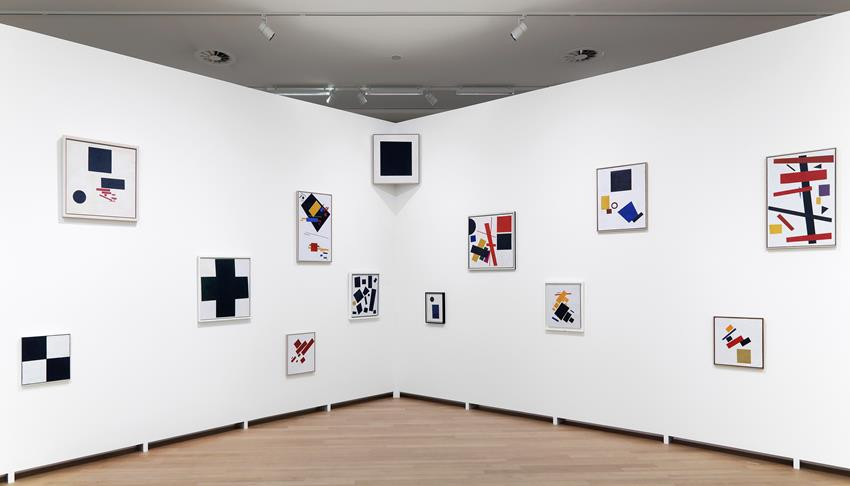stedelijk│symposium: Aftermath and Afterlife of the Russian Avant-Garde
News — Jan 8, 2014
Amsterdam, January 8, 2014 – This symposium, taking place in the context of the exhibition Kazimir Malevich and the Russian Avant-garde, focuses on the interrelation between the dismantling and repression of the avant-garde in the 1920s and 1930s in Russia, and the subsequent revival and canonization of the avant-garde narrative in both the West and in post-Soviet Russia.
While the demise of the Russian avant-garde was made definitive in the 1930s by forced unification of artistic groups into the “Union of Artists,” the fate of the Russian avant-garde was in many ways already decided in the first half of the 1920s. This was partly due to the emigration of artists (such as Kandinsky, Chagall, Gabo, Falk, and Redko) and to the stylistic recalibration of a large group of moderate avant-gardists, like Aristarkh Lentulov, Vladimir Lebedev, and Pyotr Konchalovsky, into a less progressive or outright conservative painterly style.
After WWII, a new generation of artists, critics, and historians in the western hemisphere returned to the Russian avant-garde. This embrace by the western neo-avant-garde was inspired by the radicalism of the Russian aesthetic strategies and its political radicalism. Moving between cold war politics on the one hand and a neo-Marxist resistance to capitalist consumer culture on the other, this multifaceted afterlife of the Russian avant-garde in the West remained influential for a long period, ensuring that the Russian avant-garde would become a beacon for artistic freedom, radical innovation, and nonconformity in the West.
After Stalin, the avant-garde in Russia remained an ambiguous phenomenon. While it served as an important model and inspiration for the various non-conformist groups that emerged in the 1960s and 1970s, it was also considered elitist and foreign, even long after the demise of the Soviet Union. In Russian politics, the contemporary wish to highlight and strengthen the continuity between Soviet and post-Soviet period seems to be a guiding force behind the continuously problematic position of avant-garde art in and with regard to Russia.
The most important questions which this symposium seeks to address, are connected with the political nature of the avant-garde. To what extent were artists in Russia shaped by the political context of their work, or did their philosophical and aesthetic concerns prevail in the end? And if so, what strategies did they employ to preserve this aesthetical independence? In terms of reception, to what extent did the political context of the avant-garde shape a positive reception, and subsequent canonization, in the West?
The question of political context also applies to the various afterlives of the avant-garde, both in the West and in Russia. How did politics shape their aesthetics, and their philosophical program? A broad spectrum of speakers will discuss these questions and more, and relate them to the current exhibition at the Stedelijk Museum.
Program Thursday, January 16, 2014
10 am: doors open
10.30 am: welcome by Hendrik Folkerts (Curator Public Program, Stedelijk Museum) and Sjeng Scheijen (post-doctoral researcher/VENI laureate, University of Leiden).
Session 1: Neo- and post-avant-garde
Access and understanding of Russian avant-garde elements used by neo and post-avant-garde artist.
- 11 am: keynote lecture Christina Lodder (Professor Art History and Philosophy of Art, University of Kent)
- 11.45 am: questions from the audience
- 12.15 pm: roundtable with Christina Lodder (Professor Art History and Philosophy of Art University of Kent), Natalia Murray (Lecturer, Courtauld Institute of Art), and Eric de Bruyn (Lecturer Art History, University of Leiden), moderated by Margriet Schavemaker (Head of Research, Stedelijk Museum)
- 1.30 pm: end of session
- 1.30 – 3 pm: lunch break.
Session 2: Canonization
Problematic notion of the Russian avant-garde canon due to the division of various understandings of what the Russian Avant-garde represents.
- 3 pm: short lectures by Linda Boersma (Lecturer Art History, University of Utrecht), Christina Kiaer (Professor Art History, Northwestern University), and Nicoletta Misler (Professor Modern East European Art, Instituto Universitario Orientale Napels)
- 4 pm: panel discussion, moderated by Jane Sharp (University Docent 20th Century Art, Rutgers University NJ)
- 4.30 pm: end of session.
Program Friday, January 17, 2014
10.30 am: doors open
10.45 am: brief introduction by Sjeng Scheijen
Session 3: Artistic strategies
This session explores the inner world of the Russian avant-garde within strongly politicized circumstances to understand how an anti-political attitude shaped the avant-garde.
- 11 am: short lectures by Jane Sharp (University Docent 20th Century Art, Rutgers University NJ), Tim Harte (University Docent Russian Language and Culture and Co-director of the Russian Flagship Program, Bryn Mawr College), and John Bowlt professor Slavic Languages and Literature, University of Southern California)
- 12 am: panel discussion following lectures, moderated by Inge Wierda (art historian)
- 12.30 pm: end of session
- 12.30 – 2 pm: lunch break.
Session 4: Politics
The interaction of the private political concerns and the realities of Soviet and pre-revolutionary political life that both affected the Russian avant-garde is discussed.
- 2 pm: short lectures by Sjeng Scheijen, Alexandra Shatskikh (freelance scholar, Moscow), and Susan E. Reid (Professor Russian and Soviet Art History, University of Sheffield)
- 3 pm: panel discussion
- 3.30 pm: end of session
- 3.45 pm: concluding remarks by Margriet Schavemaker (Head of Research, Stedelijk Museum)
- 4.30 pm: end of symposium.
Location: Teijin Auditorium, Stedelijk Museum
Language: English
Admission: Entrance price to the museum
Reservations: via reservations@stedelijk.nl
Note for editors:
For more information: Press Office, tel. +31 (0)20 – 573 26 56 or pressoffice@stedelijk.nl.

